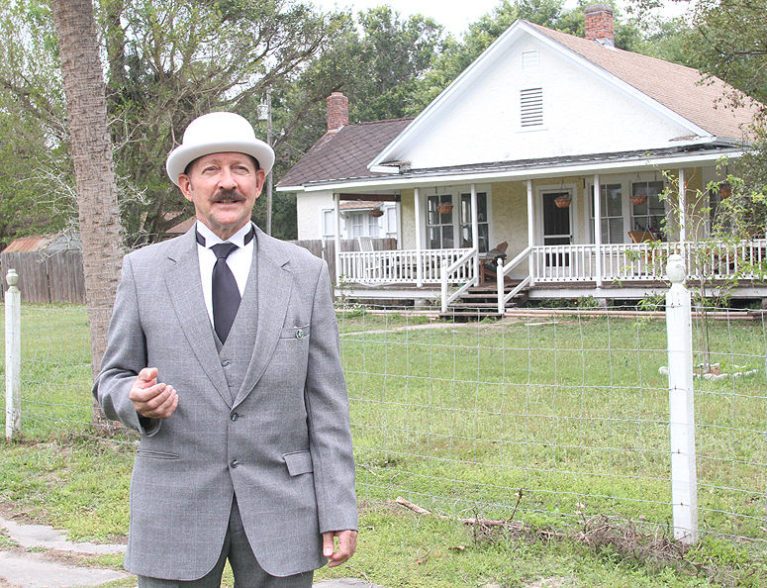
FELLSMERE — More than a hundred years old, the City of Fellsmere’s historic houses are beginning to fade into the past. Some burn down, others wear out. Still more are knocked down to make way for new buildings and development.
As each one disappears, a piece of the city’s history goes along with it.
“I would like to see all the buildings preserved in some way or another,” said Fellsmere historian Rich Votapka, noting that the homes represent more than a piece of the city’s past. They also are examples of architectural styles that are rare today. “I’d hate to see that come to an end.”
The Fellsmere City Council has expressed interest in coming up with a plan to preserve the remaining historic homes from demolition and significant modification. And, to that end, city leaders are exploring how to accomplish such a goal.
City Attorney Warren Dill laid out a basic framework – commission an accurate survey of homes and establish an ordinance outlining what can and cannot be done to the structures.
The impetus for the discussion was a query from a potential developer who expressed interest in opening a dollar store on N. Elm Street, at the corner of County Road 512.
That person, who City Manager Jason Nunemaker did not identify, said plans were tentative and wondered about demolishing the circa 1926 Mediterranean style home to make way for the store.
Nunemaker told the person that the city would rather see the home relocated than torn down. The house could be moved to the Marian Fell Library campus on N. Cypress Street.
Votapka expressed concern that the home could be torn down, explaining that it was once the home of Americus Day, a former Fellsmere Mayor and City Councilman.
The Days moved into the home in 1940 but have since sold it.
Nunemaker told the Fellsmere City Council during a recent meeting that the city is fairly well equipped to handle commercial redevelopment of historic homes – it’s the residential development that poses more challenges.
“There’s not much wherewithal to do retrofits,” Nunemaker said of encouraging private homeowners to restore their homes to historic standards.
One way to achieve that goal, though, could be to offer city grants through the Community Redevelopment Agency, enticing period-accurate renovations. The biggest hurdle to that, though, is the CRA’s budget is essentially zero.
“It’s basically hibernating,” Nunemaker said, explaining that property values have leveled off and are not increasing. Those increases are what fund the CRA’s coffers.
Another option the council could consider is educating the owners of historic homes about the significance of their houses.
Nunemaker pointed to other towns that have a historic core as examples for how Fellsmere could tackle the issue.
Some, he said, are “very onerous” – placing restrictions such as the acceptable colors of paint that could be used.
He said that the city would have to come up with a balance between the needs of the residents and the council.
“You don’t want people to sour” on renovating their historic homes.
There are two homes that are particularly special to Votapka, which he’d like to see renovated and preserved.
They sit a block north of the Marian Fell Library, just passed New York Avenue.
The one on the northwest corner of Cypress and New York was the home of Fellsmere Chief Engineer Irwin Lhoyd. The one two doors north of that, was the home of Assistant Engineer William Alden James.
Both were built around the time Fellsmere was incorporated as a city and represent the craftsman architectural style.
“I care because of (Lhoyd’s) historical significance,” Votapka said. Lhoyd pioneered the development of Fellsmere, as well as the railroad.
He likened the home’s significance to that of the Savannah, Ga., home of Juliette Gordon Low, who founded the Girl Scouts of America.
Ideally, Votapka said he’d like to see the city buy both Lhoyd’s and James’ homes and convert them to mini-museums where visitors could walk through and get a sense of what life was like in the early 1900s.
“They had a lot of responsibility in developing Fellsmere,” Votapka said.
Being just a short walk down Cypress from the Marian Fell Library, Votapka said the homes could easily be incorporated into a walking tour of the city. He periodically conducts walking tours through town, dressed as Fellsmere founder E. Nelson Fell.
Fell’s home is believed to be directly across the street from the Marian Fell Library, so named for Fell’s daughter, who established the library for the town’s residents.
Votapka said he has not been able to confirm that 88 N. Cypress was indeed Fell’s home, however.
As for the Americus Day house on N. Elm, Votapka said he’d rather see the house stay where it is because the home’s location is as important as the house itself.
But he said he could support uprooting and relocating the house to the Marian Fell Library campus in order to preserve it.
“That would be ideal,” Votapka said.



